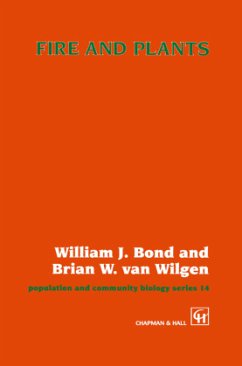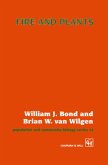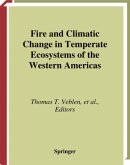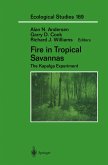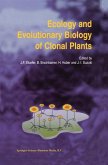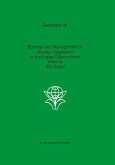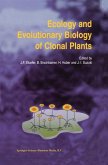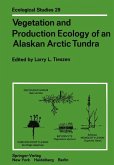- Broschiertes Buch
- Merkliste
- Auf die Merkliste
- Bewerten Bewerten
- Teilen
- Produkt teilen
- Produkterinnerung
- Produkterinnerung
Large regions of the world are regularly burnt either deliberately or naturally. However, despite the widespread occurrence of such fire-prone ecosystems, and considerable body of research on plant population biology in relation to fire, until now there have only been limited attempts at a coherent conceptual synthesis of the field for use by students or researchers.
Andere Kunden interessierten sich auch für
![Fire and Plants Fire and Plants]() W. BondFire and Plants161,99 €
W. BondFire and Plants161,99 €![Fire and Climatic Change in Temperate Ecosystems of the Western Americas Fire and Climatic Change in Temperate Ecosystems of the Western Americas]() Fire and Climatic Change in Temperate Ecosystems of the Western Americas112,99 €
Fire and Climatic Change in Temperate Ecosystems of the Western Americas112,99 €![Fire in Tropical Savannas Fire in Tropical Savannas]() Fire in Tropical Savannas112,99 €
Fire in Tropical Savannas112,99 €![Ecology and Evolutionary Biology of Clonal Plants Ecology and Evolutionary Biology of Clonal Plants]() Josef F. Stuefer / Brigitta Erschbamer / Heidrun Huber / Jun-Ichirou Suzuki (Hgg.)Ecology and Evolutionary Biology of Clonal Plants161,99 €
Josef F. Stuefer / Brigitta Erschbamer / Heidrun Huber / Jun-Ichirou Suzuki (Hgg.)Ecology and Evolutionary Biology of Clonal Plants161,99 €![Ecology and management of aquatic vegetation in the Indian subcontinent Ecology and management of aquatic vegetation in the Indian subcontinent]() Ecology and management of aquatic vegetation in the Indian subcontinent161,99 €
Ecology and management of aquatic vegetation in the Indian subcontinent161,99 €![Ecology and Evolutionary Biology of Clonal Plants Ecology and Evolutionary Biology of Clonal Plants]() Ecology and Evolutionary Biology of Clonal Plants150,99 €
Ecology and Evolutionary Biology of Clonal Plants150,99 €![Vegetation and Production Ecology of an Alaskan Arctic Tundra Vegetation and Production Ecology of an Alaskan Arctic Tundra]() Vegetation and Production Ecology of an Alaskan Arctic Tundra81,99 €
Vegetation and Production Ecology of an Alaskan Arctic Tundra81,99 €-
-
-
Large regions of the world are regularly burnt either deliberately or naturally. However, despite the widespread occurrence of such fire-prone ecosystems, and considerable body of research on plant population biology in relation to fire, until now there have only been limited attempts at a coherent conceptual synthesis of the field for use by students or researchers.
Hinweis: Dieser Artikel kann nur an eine deutsche Lieferadresse ausgeliefert werden.
Hinweis: Dieser Artikel kann nur an eine deutsche Lieferadresse ausgeliefert werden.
Produktdetails
- Produktdetails
- Population and Community Biology Series 14
- Verlag: Springer / Springer Netherlands
- Artikelnr. des Verlages: 978-94-010-7170-3
- Softcover reprint of the original 1st ed. 1996
- Seitenzahl: 280
- Erscheinungstermin: 28. September 2011
- Englisch
- Abmessung: 235mm x 155mm x 16mm
- Gewicht: 429g
- ISBN-13: 9789401071703
- ISBN-10: 9401071705
- Artikelnr.: 39500129
- Herstellerkennzeichnung Die Herstellerinformationen sind derzeit nicht verfügbar.
- Population and Community Biology Series 14
- Verlag: Springer / Springer Netherlands
- Artikelnr. des Verlages: 978-94-010-7170-3
- Softcover reprint of the original 1st ed. 1996
- Seitenzahl: 280
- Erscheinungstermin: 28. September 2011
- Englisch
- Abmessung: 235mm x 155mm x 16mm
- Gewicht: 429g
- ISBN-13: 9789401071703
- ISBN-10: 9401071705
- Artikelnr.: 39500129
- Herstellerkennzeichnung Die Herstellerinformationen sind derzeit nicht verfügbar.
1 Introduction.- 1.1 The global importance of fire.- 1.2 Why we have written this book.- 1.3 What this book is about.- 1.4 Methods of fire ecology.- 1.5 Ecological concepts and fire ecology.- 1.6 Fire and the ecology of plants.- 2 Why and how do ecosystems burn?.- 2.1 The fire regime.- 2.2 Prerequisites for fire.- 2.3 Plants as 'fuel': what makes vegetation flammable?.- 2.4 Fire recurrence intervals and their measurement.- 2.5 Temperature of fires and survival of plant tissues.- 2.6 Conclusions.- 3 Surviving fires - vegetative and reproductive responses.- 3.1 Vegetative survival.- 3.2 The post-burn environment as reproductive stimulus.- 3.3 Reproduction and fire.- 3.4 Fire life-histories.- 3.5 Conclusions.- 4 Plant demography and fire I. Interval-dependent effects.- 4.1 Introduction.- 4.2 Types of population growth.- 4.3 Modelling populating growth.- 4.4 Demography and the fire-interval hypothesis.- 4.5 Density dependence and population regulation - the self-regulatory hypothesis.- 4.6 Event-dependent dynamics and population regulation.- 4.7 Conclusion.- 5 Plant demography and fire II. Event-dependent effects.- 5.1 Introduction.- 5.2 Effects of fire intensity and season on survival.- 5.3 Effects of fire intensity and season on recruitment.- 5.4 Effects of climate variation on recruitment.- 5.5 Effects of ground fires.- 5.6 Effects of fire area.- 5.7 The causes of event-dependent effects.- 5.8 Explaining survival patterns.- 5.9 Explaining recruitment patterns.- 5.10 Predicting event-dependent effects.- 5.11 Event-dependent effects in different biomes.- 5.12 Conclusions.- 6 Fire and the evolutionary ecology of plants.- 6.1 Fire and the evolution of plant traits.- 6.2 Sprouters versus non-sprouters.- 6.3 Life-history evolution.- 6.4 Timing of reproduction andrecruitment.- 6.5 Evolution of fire-survival traits.- 6.6 Evolution of flammability.- 6.7 Conclusions.- 7 Fire, competition and the organization of communities.- 7.1 Introduction.- 7.2 What determines changes in plant communities over time?.- 7.3 What determines spatial patterns in communities?.- 7.4 Which combinations of species occur together and why?.- 7.5 Determinants of species diversity.- 7.6 Which rules for which communities?.- 7.7 Conclusions.- 8 Fire and management.- 8.1 Introduction.- 8.2 Fire as a versatile management practice.- 8.3 Predicting the ecological effects of fire.- 8.4 Managing fires.- 8.5 Conclusions.- 9 Fire and the ecology of a changing world.- 9.1 Introduction.- 9.2 Climate, fire and biogeography.- 9.3 Changing patterns of fire in modern landscapes.- 9.4 Ecological consequences of changing fire regimes.- 9.5 Conclusions.- References.- Species Index.
1 Introduction.- 1.1 The global importance of fire.- 1.2 Why we have written this book.- 1.3 What this book is about.- 1.4 Methods of fire ecology.- 1.5 Ecological concepts and fire ecology.- 1.6 Fire and the ecology of plants.- 2 Why and how do ecosystems burn?.- 2.1 The fire regime.- 2.2 Prerequisites for fire.- 2.3 Plants as 'fuel': what makes vegetation flammable?.- 2.4 Fire recurrence intervals and their measurement.- 2.5 Temperature of fires and survival of plant tissues.- 2.6 Conclusions.- 3 Surviving fires - vegetative and reproductive responses.- 3.1 Vegetative survival.- 3.2 The post-burn environment as reproductive stimulus.- 3.3 Reproduction and fire.- 3.4 Fire life-histories.- 3.5 Conclusions.- 4 Plant demography and fire I. Interval-dependent effects.- 4.1 Introduction.- 4.2 Types of population growth.- 4.3 Modelling populating growth.- 4.4 Demography and the fire-interval hypothesis.- 4.5 Density dependence and population regulation - the self-regulatory hypothesis.- 4.6 Event-dependent dynamics and population regulation.- 4.7 Conclusion.- 5 Plant demography and fire II. Event-dependent effects.- 5.1 Introduction.- 5.2 Effects of fire intensity and season on survival.- 5.3 Effects of fire intensity and season on recruitment.- 5.4 Effects of climate variation on recruitment.- 5.5 Effects of ground fires.- 5.6 Effects of fire area.- 5.7 The causes of event-dependent effects.- 5.8 Explaining survival patterns.- 5.9 Explaining recruitment patterns.- 5.10 Predicting event-dependent effects.- 5.11 Event-dependent effects in different biomes.- 5.12 Conclusions.- 6 Fire and the evolutionary ecology of plants.- 6.1 Fire and the evolution of plant traits.- 6.2 Sprouters versus non-sprouters.- 6.3 Life-history evolution.- 6.4 Timing of reproduction andrecruitment.- 6.5 Evolution of fire-survival traits.- 6.6 Evolution of flammability.- 6.7 Conclusions.- 7 Fire, competition and the organization of communities.- 7.1 Introduction.- 7.2 What determines changes in plant communities over time?.- 7.3 What determines spatial patterns in communities?.- 7.4 Which combinations of species occur together and why?.- 7.5 Determinants of species diversity.- 7.6 Which rules for which communities?.- 7.7 Conclusions.- 8 Fire and management.- 8.1 Introduction.- 8.2 Fire as a versatile management practice.- 8.3 Predicting the ecological effects of fire.- 8.4 Managing fires.- 8.5 Conclusions.- 9 Fire and the ecology of a changing world.- 9.1 Introduction.- 9.2 Climate, fire and biogeography.- 9.3 Changing patterns of fire in modern landscapes.- 9.4 Ecological consequences of changing fire regimes.- 9.5 Conclusions.- References.- Species Index.

